Topics
Category
Era
Minnesota Valley Historical Society
The "Faithful Indians" Monument, fifty-two feet in height, erected by the Minnesota Valley Historical Society at the Birch Coulee battlefield site in Renville County, Minnesota. Photo by K. Linzmeier, September 25, 2013.
The Minnesota Valley Historical Society (MVHS) was formed in 1895 under the leadership of Charles D. Gilfillan to determine and mark sites significant to the US–Dakota War of 1862 in Redwood and Renville counties. MVHS was largely Gilfillan’s project. He founded it, was its principal leader during its most active period, and personally funded significant portions of its work. After his death in 1902, MVHS became much less active, and the group dissolved in 1915.
Before Gilfillan founded MVHS, the Minnesota state legislature had appointed him to a commission in charge of erecting a monument to commemorate the Battle of Birch Coulee—a project completed in 1894 in Morton, Minnesota. MVHS was Gilfillan’s effort to extend this work of creating public markers of the US–Dakota War. More specifically, as reported by the New Ulm Review, MVHS sought to mark “the early battle grounds and camping places” that represented Dakota attacks on the Lower Sioux Agency and settler-colonists in the surrounding area, with an emphasis on attacks made on August 18, 1862.
The choice to focus on these specific events is explained in Sketches Historical and Descriptive of the Monuments and Tablets Erected by the Minnesota Valley Historical Society in Renville and Redwood Counties, Minnesota, published by MVHS in 1902. MVHS argued that historians consistently overlooked the US–Dakota War due to its concurrence with the US Civil War. Citing the loss of settler-colonist lives (estimated at over 600 over the course of the six-week-long war) and the value of property damage, MVHS claimed the US–Dakota War was “the most formidable and important Indian War in American history.”
MVHS carried out the majority of its plans in 1898. In a short period of time, it erected approximately twelve granite historical markers. Six of them pertained to the Dakota attack on the Lower Sioux Agency on August 18, 1862: a small monument marking the grave of J. W. Lynde, who was among the first settler-colonists killed; three markers of the locations of trading houses where the attack began; a monument to US soldiers killed at Redwood Ferry; and a marker of the supposed location of the frame house of Taoyateduta (His Red Nation, also known as Little Crow), dated August 18, 1862. An additional marker at the Lower Sioux Agency identified the location where Henry Sibley’s military commission conducted trials of accused Dakota prisoners.*
Four markers on the battlefield of Birch Coulee identified the locations of specific moments during the battle. A lone marker in Redwood County was installed near the Minnesota River at the location of Camp Pope, from which Sibley launched part of the Punitive Expeditions against the Dakota in the summer of 1863.
The largest and most famous MVHS monument, erected in 1899, is known as the “Faithful Indians” or “Loyal Indians” monument and stands fifty-two feet tall near the Birch Coulee State Monument. A virtue is inscribed on each of the four sides of the plinth: “Humanity,” “Patriotism,” “Fidelity,” and “Courage.” MVHS’s 1902 publication explains the monument was made “to honor the services of those Indians who have been of eminent service to the whites” during the US–Dakota War. MVHS applied strict criteria to determine which Dakota individuals had been “truly loyal to the whites throughout the entire period of the outbreak,” which excluded mixed-race and/or métis individuals and required them to have saved the life of at least one settler-colonist. Only six individuals were chosen to have their names inscribed, and a significant portion of MVHS’s 1902 publication is dedicated to biographies of the inscribed and analyzing the definition of “truly loyal.”
The interpretation that MVHS offered in its 1902 publication and memorialized through its historical markers and monuments presented an incomplete view of the US–Dakota War. Since MVHS aimed to honor the settler-colonist victims of the war, it omitted informative context, including the series of events leading to the war, widespread Dakota opposition, and limited Dakota participation. It also overlooked the noncombatant Native Americans targeted by the concentration camp at Fort Snelling and the Punitive Expeditions, which aimed to expel all remaining Dakota and Ho-Chunk people from Minnesota after the war.
*Editor’s note: The MVHS marker mischaracterized the trials organized by Sibley in 1862 as a “Court Martial”; more precisely, the proceedings were convened by a military commission. For debates surrounding the trials’ legitimacy, as well as Sibley’s authority to convene them, see Chomsky, Haymond, and Herbert, cited in the bibliography below.
Bibliography
“After Thirty Years.” Mantorville Express, January 26, 1900.
“The Battle of Birch Coulee.” Historical Marker Database.
https://www.hmdb.org/m.asp?m=71795
“The Battle of Birch Coulee: Big Eagle.” Historical Marker Database.
https://www.hmdb.org/m.asp?m=67764
“The Battle of Birch Coulee: Gray Bird. Historical Marker Database.
https://www.hmdb.org/m.asp?m=154042
“The Battle of Birch Coulee: Mah-Ka-To.” Historical Marker Database.
https://www.hmdb.org/m.asp?m=69389
Chomsky, Carol. “The United States-Dakota War Trials: A Study in Military Injustice.” Stanford Law Review 43 (1990): 23n58.
https://scholarship.law.umn.edu/faculty_articles/226
“Court Martial Site.” Historical Marker Database.
https://www.hmdb.org/m.asp?m=67772
“Dedicates Scene of ‘62 Massacre.” International Falls Press and Border Budget, August 26, 1915.
“The Faithful Indians’ Monument.” Historical Marker Database.
https://www.hmdb.org/m.asp?m=69496
“Forbes’ Trading Post Site." Historical Marker Database.
https://www.hmdb.org/m.asp?m=67880
Fridley, Russel W. “Preserving and Interpreting Minnesota’s Historic Sites.” Minnesota History 37, no. 2 (Summer 1960): 58–70.
http://collections.mnhs.org/MNHistoryMagazine/articles/37/v37i02p058-070.pdf
Gilman, Rhoda R. Henry Hastings Sibley: Divided Heart. St. Paul: Minnesota Historical Society Press, 2004.
“Good Man Gone.” New Ulm Review, December 24, 1902.
Haymond, John A. The Infamous Dakota War Trials of 1862: Revenge, Military Law and the Judgment of History. Jefferson, NC: McFarland, 2016.
Herbert, Maeve. “Explaining the Sioux Military Commission of 1862." Columbia Human Rights Law Review 40, no. 743 (2009): 756–57.
https://scholarship.law.columbia.edu/cgi/viewcontent.cgi?article=4374&context=faculty_scholarship
HF 126: An act to permit the Minnesota Valley Historical Society to erect a monument upon state grounds, the perpetuate the names of Indians faithful to the whites in the Sioux massacre of 1862. Minnesota State Legislature, February 3, 1899. https://www.revisor.mn.gov/laws/1899/0/General+Laws/Chapter/2/pdf
HF 579: An act for appropriating money for the purchase of the battle field of Birch Coulie [sic] and the erection of a suitable monument thereon. Minnesota State Legislature, April 17, 1893.
https://www.revisor.mn.gov/laws/1893/0/General+Laws/Chapter/231/pdf
Holcombe, R. I. Sketches Historical and Descriptive of the Monuments and Tablets Erected by the Minnesota Valley Historical Society in Renville and Redwood Counties, Minnesota. Morton: Minnesota Valley Historical Society, 1902.
“Honors Peaceable Reds.” St. Paul Globe, January 21, 1899.
“In Memory of Indians.” Hector Mirror, August 10, 1899.
“The Indian Monument.” Sleepy Eye Herald, September 8, 1899.
“The Local News of the Week.” New Ulm Review, February 20, 1895.
Jarchow, Merrill E. “Charles D. Gilfillan: Builder Behind the Scenes.” Minnesota History 40, no. 5 (Spring 1967): 221–232.
http://collections.mnhs.org/MNHistoryMagazine/articles/40/v40i05p221-232.pdf
“Marks Many Historic Spots.” Broad Axe, September 25, 1902.
“Minnesota Items.” Zumbrota Independent, May 25, 1899.
“Minnesota Items.” Zumbrota Independent, August 31, 1899.
“Monuments and Tablets.” Windom Reporter, August 14, 1902.
“Myrick’s Trading Post Site.” Historical Marker Database.
https://www.hmdb.org/m.asp?m=67834
“The Remains of Hon. J. W. Lynde.” Historical Marker Database.
https://www.hmdb.org/m.asp?m=67769
“Robert’s Trading Post Site.” Historical Marker Database.
https://www.hmdb.org/m.asp?m=67845
“Saved White Girl in Massacre.” Border Budget, June 13, 1908.
“Short Items Gazetted.” Redwood Gazette, August 20, 1902.
“Spots Where Heroes Died.” New Ulm Review, January 27, 1897.
“To Mark Historic Spots.” New Ulm Review, September 11, 1895.
Wingerd, Mary Lethert. North Country: The Making of Minnesota. Minneapolis: University of Minnesota, 2010.
“Work in Committee.” Minneapolis Journal, February 19, 1901.
Related Resources
Primary
Gilfillan, Charles D. “The Early Political History of Minnesota.” Collections of the Minnesota Historical Society 9 (1901): 167–180.
https://archive.org/details/collectionsofmin09minn/page/n367/mode/2up
Return I. Holcombe papers
Manuscript Collection, Minnesota Historical Society, St. Paul
Description: Correspondence, manuscript histories, background materials, and related miscellany of this St. Paul (Minn.) author, editor, librarian, and historian.
http://www2.mnhs.org/library/findaids/00711.xml
Secondary
Guerry, Matthew. “Groups Say Birch Coulee Battle Monuments in Minnesota Are Worth Preserving, But By Who?” Duluth News Tribune, September 11, 2020.
https://www.duluthnewstribune.com/lifestyle/travel/6635536-Groups-say-Birch-Coulee-Battle-Monuments-in-Minnesota-are-worth-preserving-but-by-who
Web
Fort Ridgely. “Learn.”
https://www.mnhs.org/fortridgely/learn.
Historic Fort Snelling. “The US-Dakota War of 1862.”
https://www.mnhs.org/fortsnelling/learn/us-dakota-war
Lower Sioux Agency. “Learn.”
https://www.mnhs.org/lowersioux/learn
The US-Dakota War of 1862.
https://www3.mnhs.org/usdakotawar/
Related Images
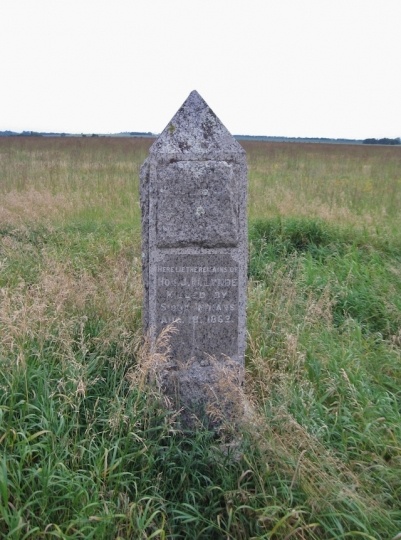
Marker at the burial site of J. W. Lynde
Marker at the burial site of J. W. Lynde (killed during the US–Dakota War of 1862) erected by the Minnesota Valley Historical Society in 1898. Photo by K. Linzmeier, July 30, 2013.
Holding Location
Articles
More Information
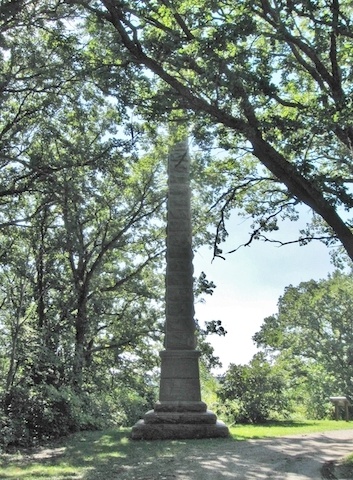
"Faithful Indians" Monument
The "Faithful Indians" Monument, fifty-two feet in height, erected by the Minnesota Valley Historical Society at the Birch Coulee battlefield site in Renville County, Minnesota. Photo by K. Linzmeier, September 25, 2013.
Holding Location
More Information
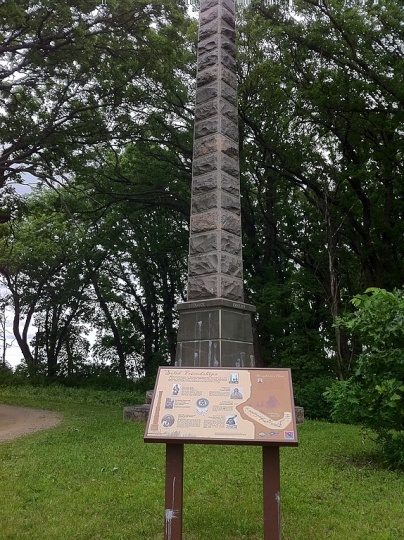
"Faithful Indians" Monument
The "Faithful Indians" Monument and interpretive signage erected by the Minnesota Valley Historical Society at the site of the Birch Coulee battlefield, Renville County, Minnesota, United States. Photo by Wikimedia Commons user Myotus, June 9, 2011. CC BY-SA 4.0.
Holding Location
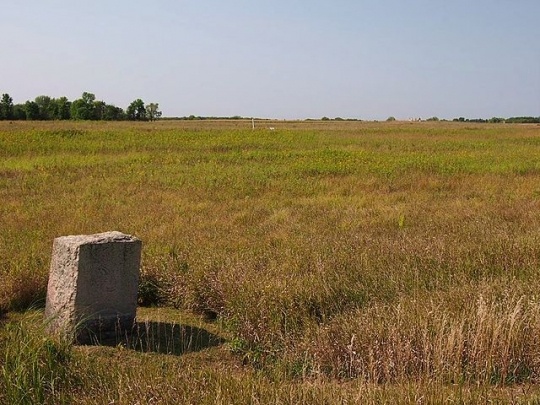
Birch Coulee battlefield monument
Marker erected by the Minnesota Valley Historical Society at the site of the Battle of Birch Coulee in Renville County, Minnesota. View from County Road 2 looking southwest. Photo by Wikimedia Commons user McGhiever, September 1, 2012. CC BY-SA 3.0.
Holding Location
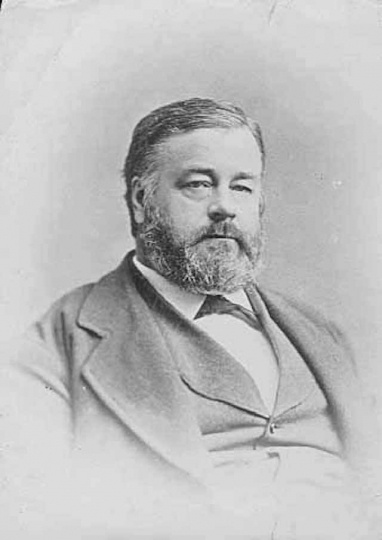
Charles Gilfillan
Charles Gilfillan, ca. 1890.
Holding Location
Articles
More Information
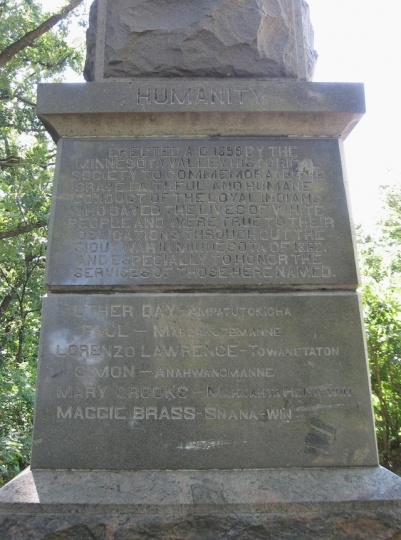
Face of the "Faithful Indians" monument
Face of the "Faithful Indians" monument erected by the Minnesota Valley Historical Society at the site of the Birch Coulee battlefield. Photo by K. Linzmeier, September 25, 2013.
Holding Location
Articles
More Information
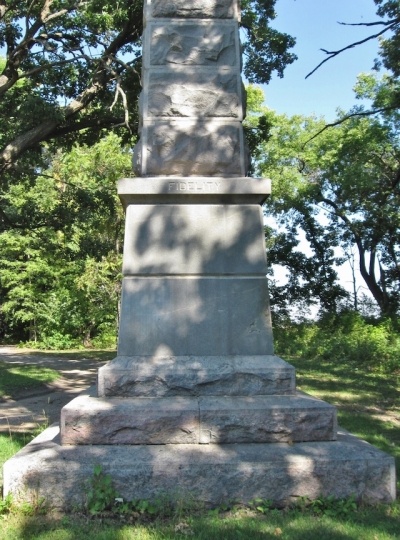
Face of the "Faithful Indians" monument
Face (without text) of the "Faithful Indians" monument erected by the Minnesota Valley Historical Society at the site of the Battle of Birch Coulee in Renville County, Minnesota.
Holding Location
Articles
More Information
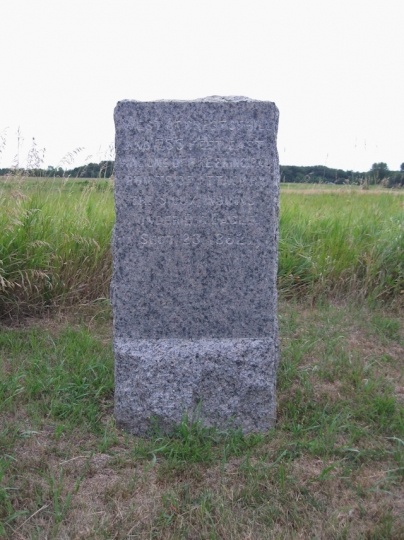
Marker at the site of the Battle of Birch Coulee
Marker erected by the Minnesota Valley Historical Society at the site of the Battle of Birch Coulee. Photograph by K. Linzmeier, July 30, 2013.
Holding Location
More Information
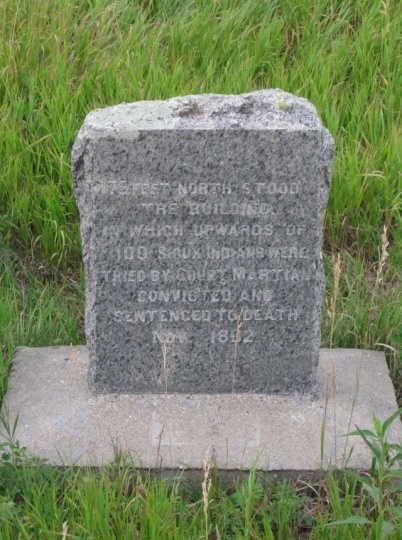
Military trials site marker
Marker at the site of military trials of Dakota men conducted after the US–Dakota War of 1862. Erected by the Minnesota Valley Historical Society in 1898. Photo by K. Linzmeier, July 30, 2013.
Holding Location
Articles
More Information

Marker at the site of Andrew Myrick's trading post
Marker at the site of Andrew Myrick's trading post erected by the Minnesota Valley Historical Society in 1898. Photo by K. Linzmeier, July 30, 2013.
Holding Location
Articles
More Information
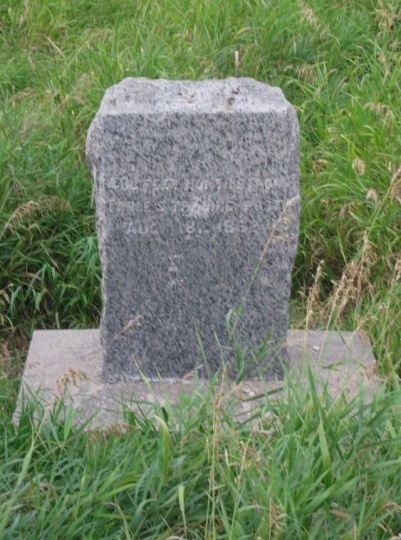
Marker at the site of Forbes' trading post
Marker erected at the site of Forbes' trading post (important before and during the US–Dakota War of 1862) by the Minnesota Valley Historical Society in 1898. Photo by K. Linzmeier, July 30, 2013.
Holding Location
Articles
More Information
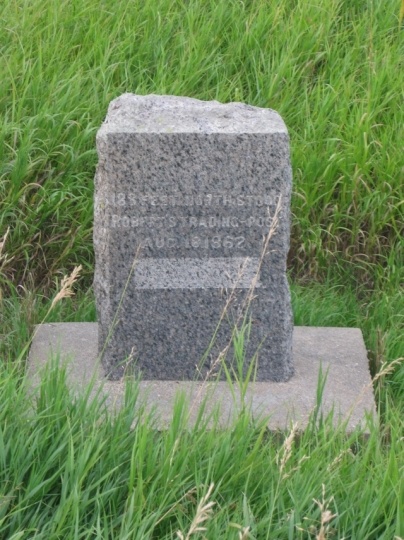
Marker at the site of Roberts' trading post
Marker at the site of Roberts' trading post (used before and during the US–Dakota War of 1862) erected by the Minnesota Valley Historical Society in 1898. Photo by K. Linzmeier, July 30, 2013.
Holding Location
Articles
More Information

Marker at the burial site of J. W. Lynde
Marker at the burial site of J. W. Lynde (killed during the US–Dakota War of 1862) erected by the Minnesota Valley Historical Society in 1898. Photo by K. Linzmeier, July 30, 2013.
Holding Location
Articles
More Information

"Faithful Indians" Monument
The "Faithful Indians" Monument, fifty-two feet in height, erected by the Minnesota Valley Historical Society at the Birch Coulee battlefield site in Renville County, Minnesota. Photo by K. Linzmeier, September 25, 2013.
Holding Location
More Information

"Faithful Indians" Monument
The "Faithful Indians" Monument and interpretive signage erected by the Minnesota Valley Historical Society at the site of the Birch Coulee battlefield, Renville County, Minnesota, United States. Photo by Wikimedia Commons user Myotus, June 9, 2011. CC BY-SA 4.0.
Holding Location

Birch Coulee battlefield monument
Marker erected by the Minnesota Valley Historical Society at the site of the Battle of Birch Coulee in Renville County, Minnesota. View from County Road 2 looking southwest. Photo by Wikimedia Commons user McGhiever, September 1, 2012. CC BY-SA 3.0.
Holding Location

Charles Gilfillan
Charles Gilfillan, ca. 1890.
Holding Location
Articles
More Information

Face of the "Faithful Indians" monument
Face of the "Faithful Indians" monument erected by the Minnesota Valley Historical Society at the site of the Birch Coulee battlefield. Photo by K. Linzmeier, September 25, 2013.
Holding Location
Articles
More Information

Face of the "Faithful Indians" monument
Face (without text) of the "Faithful Indians" monument erected by the Minnesota Valley Historical Society at the site of the Battle of Birch Coulee in Renville County, Minnesota.
Holding Location
Articles
More Information

Marker at the site of the Battle of Birch Coulee
Marker erected by the Minnesota Valley Historical Society at the site of the Battle of Birch Coulee. Photograph by K. Linzmeier, July 30, 2013.
Holding Location
More Information

Military trials site marker
Marker at the site of military trials of Dakota men conducted after the US–Dakota War of 1862. Erected by the Minnesota Valley Historical Society in 1898. Photo by K. Linzmeier, July 30, 2013.
Holding Location
Articles
More Information

Marker at the site of Andrew Myrick's trading post
Marker at the site of Andrew Myrick's trading post erected by the Minnesota Valley Historical Society in 1898. Photo by K. Linzmeier, July 30, 2013.
Holding Location
Articles
More Information

Marker at the site of Forbes' trading post
Marker erected at the site of Forbes' trading post (important before and during the US–Dakota War of 1862) by the Minnesota Valley Historical Society in 1898. Photo by K. Linzmeier, July 30, 2013.
Holding Location
Articles
More Information

Marker at the site of Roberts' trading post
Marker at the site of Roberts' trading post (used before and during the US–Dakota War of 1862) erected by the Minnesota Valley Historical Society in 1898. Photo by K. Linzmeier, July 30, 2013.
Holding Location
Articles
More Information

Marker at the burial site of J. W. Lynde
Marker at the burial site of J. W. Lynde (killed during the US–Dakota War of 1862) erected by the Minnesota Valley Historical Society in 1898. Photo by K. Linzmeier, July 30, 2013.
Holding Location
Articles
More Information
Related Articles
Turning Point
In 1898, the Minnesota Valley Historical Society erects approximately twelve granite historical markers at the Lower Sioux Agency, the Birch Coulee battlefield, and other locations in Redwood and Renville counties.
Chronology
1894
1895
1898
1898
1898
1898
1898
1898
1898
1898
1898
1898
1898
1898
1899
1899
1902
1902
1908
1915
Bibliography
“After Thirty Years.” Mantorville Express, January 26, 1900.
“The Battle of Birch Coulee.” Historical Marker Database.
https://www.hmdb.org/m.asp?m=71795
“The Battle of Birch Coulee: Big Eagle.” Historical Marker Database.
https://www.hmdb.org/m.asp?m=67764
“The Battle of Birch Coulee: Gray Bird. Historical Marker Database.
https://www.hmdb.org/m.asp?m=154042
“The Battle of Birch Coulee: Mah-Ka-To.” Historical Marker Database.
https://www.hmdb.org/m.asp?m=69389
Chomsky, Carol. “The United States-Dakota War Trials: A Study in Military Injustice.” Stanford Law Review 43 (1990): 23n58.
https://scholarship.law.umn.edu/faculty_articles/226
“Court Martial Site.” Historical Marker Database.
https://www.hmdb.org/m.asp?m=67772
“Dedicates Scene of ‘62 Massacre.” International Falls Press and Border Budget, August 26, 1915.
“The Faithful Indians’ Monument.” Historical Marker Database.
https://www.hmdb.org/m.asp?m=69496
“Forbes’ Trading Post Site." Historical Marker Database.
https://www.hmdb.org/m.asp?m=67880
Fridley, Russel W. “Preserving and Interpreting Minnesota’s Historic Sites.” Minnesota History 37, no. 2 (Summer 1960): 58–70.
http://collections.mnhs.org/MNHistoryMagazine/articles/37/v37i02p058-070.pdf
Gilman, Rhoda R. Henry Hastings Sibley: Divided Heart. St. Paul: Minnesota Historical Society Press, 2004.
“Good Man Gone.” New Ulm Review, December 24, 1902.
Haymond, John A. The Infamous Dakota War Trials of 1862: Revenge, Military Law and the Judgment of History. Jefferson, NC: McFarland, 2016.
Herbert, Maeve. “Explaining the Sioux Military Commission of 1862." Columbia Human Rights Law Review 40, no. 743 (2009): 756–57.
https://scholarship.law.columbia.edu/cgi/viewcontent.cgi?article=4374&context=faculty_scholarship
HF 126: An act to permit the Minnesota Valley Historical Society to erect a monument upon state grounds, the perpetuate the names of Indians faithful to the whites in the Sioux massacre of 1862. Minnesota State Legislature, February 3, 1899. https://www.revisor.mn.gov/laws/1899/0/General+Laws/Chapter/2/pdf
HF 579: An act for appropriating money for the purchase of the battle field of Birch Coulie [sic] and the erection of a suitable monument thereon. Minnesota State Legislature, April 17, 1893.
https://www.revisor.mn.gov/laws/1893/0/General+Laws/Chapter/231/pdf
Holcombe, R. I. Sketches Historical and Descriptive of the Monuments and Tablets Erected by the Minnesota Valley Historical Society in Renville and Redwood Counties, Minnesota. Morton: Minnesota Valley Historical Society, 1902.
“Honors Peaceable Reds.” St. Paul Globe, January 21, 1899.
“In Memory of Indians.” Hector Mirror, August 10, 1899.
“The Indian Monument.” Sleepy Eye Herald, September 8, 1899.
“The Local News of the Week.” New Ulm Review, February 20, 1895.
Jarchow, Merrill E. “Charles D. Gilfillan: Builder Behind the Scenes.” Minnesota History 40, no. 5 (Spring 1967): 221–232.
http://collections.mnhs.org/MNHistoryMagazine/articles/40/v40i05p221-232.pdf
“Marks Many Historic Spots.” Broad Axe, September 25, 1902.
“Minnesota Items.” Zumbrota Independent, May 25, 1899.
“Minnesota Items.” Zumbrota Independent, August 31, 1899.
“Monuments and Tablets.” Windom Reporter, August 14, 1902.
“Myrick’s Trading Post Site.” Historical Marker Database.
https://www.hmdb.org/m.asp?m=67834
“The Remains of Hon. J. W. Lynde.” Historical Marker Database.
https://www.hmdb.org/m.asp?m=67769
“Robert’s Trading Post Site.” Historical Marker Database.
https://www.hmdb.org/m.asp?m=67845
“Saved White Girl in Massacre.” Border Budget, June 13, 1908.
“Short Items Gazetted.” Redwood Gazette, August 20, 1902.
“Spots Where Heroes Died.” New Ulm Review, January 27, 1897.
“To Mark Historic Spots.” New Ulm Review, September 11, 1895.
Wingerd, Mary Lethert. North Country: The Making of Minnesota. Minneapolis: University of Minnesota, 2010.
“Work in Committee.” Minneapolis Journal, February 19, 1901.
Related Resources
Primary
Gilfillan, Charles D. “The Early Political History of Minnesota.” Collections of the Minnesota Historical Society 9 (1901): 167–180.
https://archive.org/details/collectionsofmin09minn/page/n367/mode/2up
Return I. Holcombe papers
Manuscript Collection, Minnesota Historical Society, St. Paul
Description: Correspondence, manuscript histories, background materials, and related miscellany of this St. Paul (Minn.) author, editor, librarian, and historian.
http://www2.mnhs.org/library/findaids/00711.xml
Secondary
Guerry, Matthew. “Groups Say Birch Coulee Battle Monuments in Minnesota Are Worth Preserving, But By Who?” Duluth News Tribune, September 11, 2020.
https://www.duluthnewstribune.com/lifestyle/travel/6635536-Groups-say-Birch-Coulee-Battle-Monuments-in-Minnesota-are-worth-preserving-but-by-who
Web
Fort Ridgely. “Learn.”
https://www.mnhs.org/fortridgely/learn.
Historic Fort Snelling. “The US-Dakota War of 1862.”
https://www.mnhs.org/fortsnelling/learn/us-dakota-war
Lower Sioux Agency. “Learn.”
https://www.mnhs.org/lowersioux/learn
The US-Dakota War of 1862.
https://www3.mnhs.org/usdakotawar/













